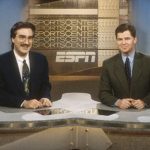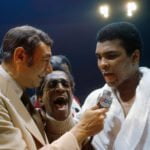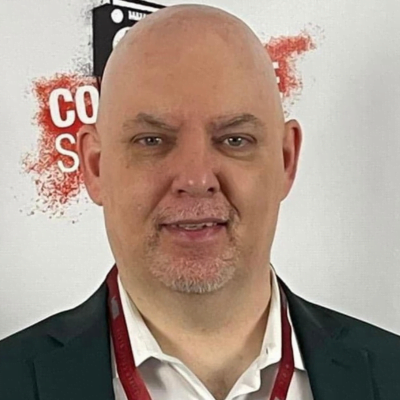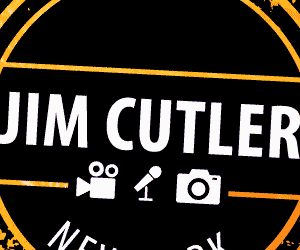What if I told you, that another sports media show or personality would be given a future 30 for 30 documentary. Who would you nominate to earn that honor?
On Thursday evening July 13th, ESPN premiered the 30 for 30 film on WFAN’s longtime afternoon show, Mike and the Mad Dog. The story revolved around Mike Francesa and Chris “Mad Dog” Russo, and the New York sports radio duo’s rise to prominence in the big apple. Mike and Chris enjoyed nineteen successful years on the air together, and in the process, influenced the growth of the entire sports radio format, and many of the broadcasters who operate in it today.
By the end of the episode, Twitter was exploding with conversation about the film, making it one of the evening’s top trending topics. The film ran sixty minutes in length, which I felt was short, but the episode brought back many great memories for those who were familiar with Mike and Chris and their importance to the sports radio format.
When the ratings came out, the film was ESPN’s highest rated 30 for 30 episode in New York City. However, it failed to gain traction outside of the nation’s top media market. Given the regional nature of sports talk radio and its personalities that wasn’t surprising.
After learning about the ratings, I began thinking to myself, which other sports media shows, hosts, stations or stories would be worthy of a similar honor? 30 for 30 films aren’t handed out to just anyone. To earn that type of respect and recognition as a media personality or show, a significant contribution to the industry must be made for a lengthy period of time.
I began jotting down ideas and contemplating who had blazed a large enough trail in the sports media business to warrant consideration. I don’t claim for this list to be bulletproof. But maybe it spurs additional ideas, and reminds us to appreciate the style, skill and special qualities that many great broadcasters have brought to the airwaves, and the life lasting connections they’ve formed with the audience.
There are many giants in our industry. Some have retired after decades of excellence. Some continue to steal the spotlight on television and radio, adding to the legacies they’ve already established. And others have joined the guy in the sky after owning space in the hearts and minds of sports fans during the length of their broadcasting careers.
It’s easy to make a case for Chris Berman, Mike and Mike, Jim Rome, Stephen A. Smith, Pardon The Interruption, Bob Costas and Al Michaels. The same can be said for Stuart Scott, John Saunders, Harry Caray and Craig Sager. And there are many others that belong in the conversation as well.
I don’t expect ESPN to create future 30 for 30 documentaries on these individuals, let alone the ones that I’m making a case for in this article, but since this is the land of make believe, and we’re all allowed to dream, I’ve laid out a few thoughts on who I think is worthy of having their story told. Each of these candidates have left an indelible mark on the sports broadcasting profession, and their ability to resonate with fans on a national level would create greater public interest in their documentaries.
If 30 for 30’s writers, filmmakers, and producers choose down the line to develop a film from one of these ideas, a simple thank you to Barrett Sports Media in the final credits will suffice. Unless of course you’re paying seven figures. In that case, call me!
But while I spend my time sitting around waiting for their call, use your next few minutes to review the three candidates that I’ve chosen, and the reasons why they deserve consideration to be featured in a future 30 for 30 documentary.
 Dan Patrick and Keith Olbermann – Before the landscape of sports television exploded with tons of options and channels, Dan Patrick and Keith Olbermann owned the attention of every sports fan across America for a five year period. The times may have been simpler, the competition less formidable, and the production quality and studio display less appealing, but when Dan and Keith took the air to host The Big Show, viewers adjusted their schedules to make sure they were in front of a television to watch them perform.
Dan Patrick and Keith Olbermann – Before the landscape of sports television exploded with tons of options and channels, Dan Patrick and Keith Olbermann owned the attention of every sports fan across America for a five year period. The times may have been simpler, the competition less formidable, and the production quality and studio display less appealing, but when Dan and Keith took the air to host The Big Show, viewers adjusted their schedules to make sure they were in front of a television to watch them perform.
From their signature catchphrases to their on-camera chemistry and the sheer joy in which they informed you about the best moments each night from the world of sports, Dan and Keith became television rock stars. They were your friends on SportsCenter and the guys who both fans and athletes each wanted to spend time hanging out and having a beer with. Their style was contagious, their laughs were natural and they inspired many to want to stand in front of camera and develop a career calling sports highlights.
The only downside to Dan and Keith’s tenure is that it didn’t last long enough. Patrick stayed at ESPN until 2006, but Olbermann was long gone, departing in 1997. Upon his exit from Bristol, a town in which Keith was not fond of and had publicly been critical of, sources said there was a better chance of hell freezing over before Olbermann would be welcomed back.
When the network celebrated 25 years of its history, Keith was the one marquee name who wasn’t present. The two sides did though finally turn the page and work together in 2013 when KO signed on to host his own self-titled nightly program. He also returned for ESPN Radio’s 25th anniversary. Patrick cut ties with the network too for a few years, but finally returned in 2015 as Scott Van Pelt’s first guest on SportsCenter.
The emergence of The Big Show gave SportsCenter the jolt of energy it needed during an important time in the show’s history. Although the program had gained ground prior to Dan and Keith’s arrival, once the two teamed up to own the 11pm ET time slot, patterns changed, allegiances were formed, and late night sports television became must-watch and must-discuss.
Since departing from the four letter network, the two broadcasters have taken different roads, enjoying varying levels of success. Olbermann expanded his profile by tossing his hat into the political arena. Patrick stayed true to his sports roots, developing a nationally syndicated radio/television show, and becoming the studio host of NBC’s Sunday Night Football. He’s also continued to make appearances in Adam Sandler films.
They say the true measure of impact is what you accomplish during the time that you’re doing it. Well, for five years Dan Patrick and Keith Olbermann owned the attention of every American sports fan, athlete, coach and executive. If 30 for 30 shined the spotlight on their influence on SportsCenter and sports television, they’d earn the nation’s attention again, even if only for an hour or two.
 Vin Scully – Like a cup of hot chocolate on a cold winter’s day, Vin Scully warmed the sports fan’s soul for over six decades. The graceful voice of the Los Angeles Dodgers was the epitome of class. He made sports fans feel like they were at the ballpark enjoying the sound of the crowd, the taste of the hot dogs and beer, and the smell of the grass, even as they relied on his magical voice to convey the excitement over their radio airwaves. You couldn’t think of the L.A. Dodgers without thinking of Vin Scully.
Vin Scully – Like a cup of hot chocolate on a cold winter’s day, Vin Scully warmed the sports fan’s soul for over six decades. The graceful voice of the Los Angeles Dodgers was the epitome of class. He made sports fans feel like they were at the ballpark enjoying the sound of the crowd, the taste of the hot dogs and beer, and the smell of the grass, even as they relied on his magical voice to convey the excitement over their radio airwaves. You couldn’t think of the L.A. Dodgers without thinking of Vin Scully.
Throughout his career, Scully shined in nearly everything he did. He was behind the microphone for Hank Aaron’s record breaking 715th home run in 1974. He called NFL games for CBS including Dwight Clark’s catch from Joe Montana against the Dallas Cowboys in the 1982 NFC Championship game. He spent 1983-1989 with NBC where he called three World Series including the classic between the New York Mets and Boston Red Sox in 1986 and the 1988 A’s-Dodgers series which included Kirk Gibson’s infamous pinch hit home run against Dennis Eckersley. He also served as the network’s lead announcer for PGA coverage, working alongside Lee Trevino.
One of the more interesting sagas of his career occurred at CBS where the network chose Pat Summerall over him to work opposite John Madden. The network felt Summerall blended better with Madden, which ultimately proved to be a good decision. The sting from that situation led Scully to NBC.
The list of awards and accomplishments that Scully racked up over his broadcast career is impressive as well. He was given the Ford Frick Award from the National Baseball Hall of Fame in 1982, honored with a Lifetime Achievement Emmy Award for sportscasting along with induction into the National Radio Hall of Fame in 1995, and was named the California sportscaster of the year 32 times. He has his own star on the Hollywood Walk of Fame, and was honored with the Icon Award at the 2017 ESPYS awards show.
Scully was America’s friend on the radio, a master at painting pictures with words, and his excellence continued until his final sentence was uttered in 2016.
The only challenge with producing a Vin Scully documentary is that it’s missing a lot of negativity and friction. Maybe I’m naive to think that respect, decency, and greatness would be enough to make people care, but I’d roll the dice on telling the story of one of America’s finest broadcasters. A story about Vin would not only capture a few eyeballs, but it’d also leave them wet.
 Howard Cosell – Few sportscasters were as successful, influential, controversial and colorful as Howard Cosell. Many loved him. Others hated him. But all paid attention to him.
Howard Cosell – Few sportscasters were as successful, influential, controversial and colorful as Howard Cosell. Many loved him. Others hated him. But all paid attention to him.
What made Cosell a trailblazer was his uncomfortable and unapologetic approach which often ruffled the feathers of many he spoke with. He was a bombastic personality with a huge ego who referred to himself as arrogant, obnoxious, vain, verbose and a little bit of a showoff. He stood firmly behind his convictions, often using the line “I’m just telling it like it is”.
Perhaps the New York Times described him best when they wrote his obituary in 19995. The newspaper said that Cosell entered sports broadcasting in the mid-1950s, when the predominant style was unabashed adulation. Cosell provided a brassy counterpoint which was first ridiculed, and then copied until it became the dominant note of sports broadcasting.
All of those character traits became part of Cosell’s magic. After carving out a solid niche on New York radio and television, he became a national figure thanks to his interactions with Muhammad Ali. Despite their differences as people, the two discovered an instant chemistry. They were able to cover territory in their conversations that others simply didn’t. The various twists and turns and occasional sparks, made their interviews worth the price of admission.
Cosell was one of the first sportscasters to support Ali when he refused to be inducted into the military. He also publicly supported John Carlos and Tommie Smyth after they raised their fists in a “black power” salute during the 1968 medal ceremony. Most broadcasters sought to steer clear of social and racial issues, but Cosell embraced them, enhancing his public profile, but creating mixed reactions along the way.
It was Cosell who was behind the microphone for one of the most memorable moments in professional boxing history. The brash broadcaster screamed “Down Goes Frazier. Down Goes Frazier. Down Goes Frazier” after George Foreman rattled Smokin’ Joe Frazier in round 1 of their 1973 heavyweight title fight. Foreman would go on to knock out the champion in round 2. The call remains one of the most popular in sports broadcasting history.
To have one of those moments is special enough, but another on-air moment is equally as important to Cosell’s legacy as any other. During a Monday Night Football game between the Miami Dolphins and New England Patriots on December 8, 1980, Cosell stunned the audience by revealing that John Lennon of The Beatles had been shot and killed outside of his apartment in New York City. At first, Cosell was hesitant to announce the news of Lennon’s death, but after being pressed by Frank Gifford, he eventually relayed the information, making it one of the most defining on-air moments in sports television history.
There are many other acts, moments, controversies and contributions that make up the Howard Cosell story. From his introduction of the line “The Bronx Is Burning”, to his controversial remarks about Redskins wide receiver Alvin Garrett, to his best selling memoir “I Never Played The Game” which created tension at ABC and led to his dismissal, Cosell was a colorful and complicated individual. That’s usually what makes for compelling and entertaining programming. If 30 for 30 chose to tell his story, I don’t think they’d struggle to find an audience for it. The beauty of sports media is that it never stops producing interesting personalities and stories. The growing amount of networks and platforms, and interest among viewers, readers and listeners, means we’ll have plenty to choose from when determining which trendsetters and game changers warrant a documentary worthy of the world’s attention, and which ones have built a nice niche but are best remembered in their local backyards.
The beauty of sports media is that it never stops producing interesting personalities and stories. The growing amount of networks and platforms, and interest among viewers, readers and listeners, means we’ll have plenty to choose from when determining which trendsetters and game changers warrant a documentary worthy of the world’s attention, and which ones have built a nice niche but are best remembered in their local backyards.
Maybe one day we’ll profile the digital empire Bill Simmons built. Or Barstool Sports’ influence on sports fans. Or the impact of the Woj bomb after a decade of NBA news breaking dominance. Heck, maybe another sports radio program will have a larger impact on an audience than Mike and the Mad Dog, although I have a difficult time picturing it.
Imagine the uproar if ESPN announced a 30 for 30 was in development to profile the Embrace Debate model and how it changed sports television? The social media insanity would be worth the price of admission alone. As much as people knock it and complain about it, a case could be made that it’s not only produced ratings and big media stars for ESPN, but it’s influenced the way other television networks present their own programming. And I’m not just talking about FS1.
For many in the sports media industry this is a fun topic to debate and discuss. Selfishly we love to hear about members of our business and the stories behind their careers, even if the overall interest in the subject is less when compared to the world of sports and all that it creates. That isn’t to suggest that what we do doesn’t matter or that it’s not worthy of recognition, but choosing the right story is critically important to generating success for a film.
Let me end this column by leaving you with the question that I presented in the opening paragraph. If you were in charge of developing a 30 for 30 documentary, and tasked with creating the next big hit around a sports media personality, show or story, which one would you choose?
But let’s raise the stakes. If you choose right, you earn a lifetime contract to produce films for ESPN. If you make the wrong call, you can never film anyone or anything again.
That shouldn’t be too difficult right? After all, it’s only your career that’s on the line. Choose wisely my friends.

Jason Barrett is the President and Founder of Barrett Media since the company was created in September 2015. Prior to its arrival, JB served as a sports radio programmer, launching brands such as 95.7 The Game in San Francisco, and 101 ESPN in St. Louis. He also spent time programming SportsTalk 950 in Philadelphia, 590 The Fan KFNS in St. Louis, and ESPN 1340/1390 in Poughkeepsie, NY. Jason also worked on-air and behind the scenes in local radio at 101.5 WPDH, WTBQ 1110AM, and WPYX 106.5. He also spent two years on the national stage, producing radio shows for ESPN Radio in Bristol, CT. Among them included the Dan Patrick Show, and GameNight.
You can find JB on Twitter @SportsRadioPD. He’s also reachable by email at Jason@BarrettMedia.com.






